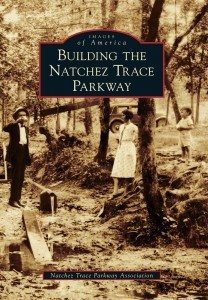I’m always intrigued by pictures and historical facts, and I love the Natchez Trace Parkway, so I was thrilled to receive an advanced copy of this pictorial history book by the Natchez Trace Parkway Association.
Who better to share photos and fun facts with the public about the Natchez Trace Parkway, right?
The Natchez Trace Parkway Association formed in 1934 to promote the development of a federal parkway commemorating the old road. Through its efforts, President Roosevelt approved the parkway as a New Deal project. The paved road was finally finished in 2005. The Natchez Trace Parkway Association continues to work toward completing the interpretive facilities and amenities to help visitors understand, appreciate, and enjoy the parkway and the story of the old Natchez Trace.
~ Source
Here’s my review of Building The Natchez Trace Parkway…
The Natchez Trace In Photos
This book reconnects people with the past through vintage images.
It’s mostly a picture book where the photo captions tell the story of how the Natchez Trace Parkway came to be.
The Natchez Trace is one of the oldest trails in North America. In 1801, President Jefferson ordered the Army to build a road along the trail to provide a route for moving troops and delivering mail. Jefferson dispatched soldiers down the road in 1803 to protect the Louisiana Purchase, and Andrew Jackson and his troops followed it to battle the British in the War of 1812. As an 1800-era link between Nashville, Tennessee, and Natchez, Mississippi, the road served as a pathway for settling much of what we now know as the South.
~ Source
My Review
Since the photos in the book are something that you’ll have to experience for yourself, I’ll summarize with a list of specific pro’s and con’s that came to mind as I was reading this book.
Pros
- It’s a picture book, so it’s loaded with photos from cover to cover.
- It’s a history book where the photo captions alone tell the story about the building of the Natchez Trace Parkway. (There are only 4 pages of written dialogue which tells the story about the Natchez Trace Parkway without any photographs.)
- It’s a quick read. Since you’re basically just reading photo captions from cover to cover, it doesn’t take long to finish this book.
- It’s a step back in time. Some of the photos will cause you to reminisce back to the days when life was simpler and more carefree than it is today, where high-tech gadgets, short attention spans, and immediate gratification are the norm.
- If you love the Natchez Trace Parkway as much as I do, then you’ll appreciate this book as a way to view the many years of hard work and dedication that went into building it.
- The section of the book that appealed to me most was the construction of the Double Arch Bridge and the northern terminus completion ceremony which took place on June 22, 1996. Dignitaries formed a motorcade of 61 cars, representing the 61 years it gook to complete the road, and became the first to travel south on the newly opened roadway from Nashville, Tennessee and across the Double Arch Bridge. Vice-President Al Gore and singer Amy Grant played major roles in the ceremony.
Vice-President Gore told the crowd that cutting ribbons was the most exciting thing he got to do as vice president.
Cons
- It’s not exactly a coffee table book. I had hoped that it would be.
- All photos are in black & white. (Naturally, due to the time period, you expect most of the historic photos to be black & whites. Yet I still longed for some color mixed in among the pages.)
- It’s not exactly a “fun” read, per se. It’s slightly burdensome to read through a book like this because there’s an equal amount of boring history mixed in with the interesting stuff. Combine that with the fact that everything is printed in straight black and white… and you’re constantly reminded that you are reading a history book.
- While necessary in order to applaud those who made this roadway become a reality, at times it seemed like there were too many photos of the dignitaries and politicians who were involved, and too few of everyday people enjoying the Natchez Trace Parkway. Therefore, it was hard to “relate” at times.
- True to its title, this book is about the building of the Natchez Trace Parkway. As a result there is very little included about the Parkway in its modern day form. The most recent photo included is from May 21, 2005 at the ceremony for the completion of the final section of roadway at mile marker 1 in Natchez, Mississippi. Of those pictured in the black & white photo, the only recognizable names to me were Senator Trent Lott and Senator Thad Cochran.
Senator Cochran observed that the Romans had built the Appian Way in less time than it took the United States to complete the Natchez Trace Parkway motor road.





